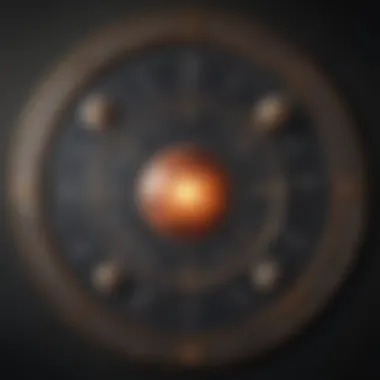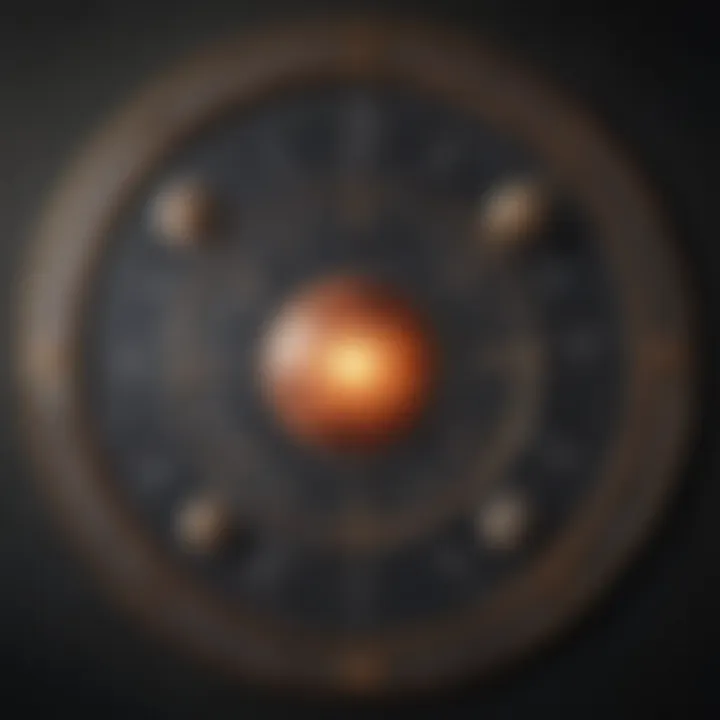Unlocking Your Birth Chart: A Guide to Astrology


Intro
Astrology provides a deep and intricate exploration of the cosmos, revealing profound insights into individual existence. Central to astrology is the full horoscope birth chart, which reflects the alignment of celestial bodies at the exact moment of one’s birth. This document is not merely a set of symbols; it is a blueprint of a person's potential, characterized by distinct traits, tendencies, and life paths.
Understanding your birth chart entails recognizing its core elements, including sun signs, moon signs, and rising signs. Each contributes uniquely to one’s personality and life experiences. A birth chart includes the positions of planets within various houses, which depict different facets of life. The interactions, or aspects, between these celestial entities further enrich the understanding of how individuals interact with the world around them. This article will delve deeper into these components to unveil the intricacies of personal growth and self-awareness through astrology.
The Basics of a Birth Chart
Understanding the basics of a birth chart is essential for anyone interested in astrology. It lays the groundwork for deeper insights into how celestial influences can shape individual personality and life experiences. A birth chart, also known as a natal chart, captures the placement of planets at the exact moment of one’s birth. This chart acts as a map that offers insights into various aspects of life, including emotional tendencies, desires, and challenges.
Definition and Importance
A birth chart is composed of twelve houses, each dedicated to a different area of life, and positions of planets and signs. These elements combined create a unique astrological profile that reflects a person's characteristics and potential life path. Understanding your birth chart helps you gain clarity about your motivations and behaviors. The evolution of personal astrology has increased its relevance in today’s society, as many seek to understand themselves better amidst modern complexities.
Benefits of Understanding Your Birth Chart:
- Self-Awareness: Gain insights into your personality traits, strengths, and weaknesses.
- Relationship Dynamics: Analyze compatibility with others based on planetary positions.
- Life Path Clarity: Identify areas for growth and opportunities.
The importance of a birth chart does not lie solely in individual traits but extends to how these traits interplay with the world around us. By examining this interrelation, one can navigate challenges and pursue personal development more effectively.
How to Obtain Your Birth Chart
Acquiring your birth chart is a straightforward process. Key steps involve gathering specific data about your birth:
- Collect Birth Information: You need to know your birth date, time, and location. Accuracy is crucial; even slight variations can impact the chart.
- Use Online Tools: Various websites offer free birth chart generation. Websites such as Astro.com allow you to input your data and receive an instant chart.
- Consult an Astrologer: For a more in-depth analysis, consider consulting a professional astrologer. They can provide interpretations that automated tools may miss.
After obtaining your birth chart, take the time to explore its components. Understanding the significance of different planetary placements and aspects opens a vast terrain of self-discovery.
Key Components of the Birth Chart
The key components of a birth chart form the foundation upon which astrological interpretations are built. These elements provide vital insights into an individual’s personality, emotions, and life journey. Within the birth chart, the three primary components stand out: the Sun sign, the Moon sign, and the Rising sign, also known as the Ascendant. Each of these components plays a distinct role in understanding how celestial influences shape an individual’s character and experiences.
The Sun Sign
The Sun sign is arguably the most recognized aspect of astrology. It represents the core of an individual's identity, embodying fundamental personality traits and motivations. The Sun sign is determined by the position of the sun at the time of birth, marking the zodiac sign that the sun was occupying. For example, someone born when the sun is in Aries will exhibit traits related to energy, courage, and leadership.
Understanding one's Sun sign is crucial as it provides insights into the overarching themes of an individual’s life. It encompasses core values and drives, influencing how one approaches relationships, work, and personal challenges. Those interested in astrology benefit from recognizing their Sun sign, as it sets the tone for self-awareness and personal development.
The Moon Sign
While the Sun sign focuses on outward identity, the Moon sign delves into the emotional and inner landscape of a person. It represents instincts, feelings, and subconscious reactions. The Moon sign is determined by the location of the moon at the time of a person's birth. For example, if the moon was in Taurus at that time, the person may have a strong need for stability and comfort in their emotional life.
The Moon sign plays a crucial role in shaping how individuals respond to their environment emotionally. Acknowledging the Moon sign can enhance understanding of personal needs and emotional processing. It offers a deeper layer of insight, often revealing aspects that are not immediately visible through the Sun sign alone. This component can help in nurturing relationships and improving communication by shining a light on emotional patterns.
The Rising Sign (Ascendant)
The Rising sign, or Ascendant, serves as the mask one wears in public. It reflects how individuals present themselves to the world and how they are perceived by others. The Ascendant is determined by the zodiac sign that was rising on the eastern horizon at the time of birth. For instance, someone with Leo rising may come across as expressive, confident, and charismatic.
The importance of the Rising sign lies in its influence on unique personality traits and behavior. It extends beyond mere appearances, affecting one's approach to life. Understanding the Ascendant can lead to greater self-acceptance and awareness of how to manage first impressions and social interactions.
Key Takeaway: The Sun sign, Moon sign, and Rising sign collectively create a multi-dimensional picture of an individual's astrological profile.
Understanding Zodiac Signs
Zodiac signs are fundamental to the study of astrology. They provide a framework through which individuals can analyze their characteristics and behaviors. Each sign has its own unique traits and influence, shaping how people respond to various life circumstances. Understanding these signs can lead to deeper self-awareness and improved interpersonal relationships. The significance of zodiac signs extends beyond mere personality traits; they serve as guides for understanding motivations and challenges.
Twelve Zodiac Signs Overview
The twelve zodiac signs are distinct with individual attributes. Each sign corresponds to a specific time of the year, aligning with certain celestial events. The signs are:
- Aries
- Taurus
- Gemini
- Cancer
- Leo
- Virgo
- Libra
- Scorpio
- Sagittarius
- Capricorn
- Aquarius
- Pisces
Each sign is associated with personality traits, strengths, and weaknesses. For instance, Aries is often seen as energetic and assertive, while Taurus is known for its reliability and a love for comfort. Understanding these differences allows individuals to navigate relationships and situations with more awareness.


Elemental Associations
Zodiac signs are also categorized based on four primary elements: fire, earth, air, and water. These elements represent different modes of expression:
- Fire Signs: Aries, Leo, Sagittarius
Associated with passion and dynamism, fire signs tend to be enthusiastic and full of life. - Earth Signs: Taurus, Virgo, Capricorn
Grounded and practical, earth signs value stability and material security. - Air Signs: Gemini, Libra, Aquarius
Intellectual and communicative, air signs thrive on social interaction and exchange of ideas. - Water Signs: Cancer, Scorpio, Pisces
Emotional and intuitive, water signs are profoundly connected to their feelings.
This elemental framework aids in understanding the fundamental nature of individuals, allowing for a more nuanced interpretation of behaviors and needs.
Modalities in Astrology
Each zodiac sign is further divided into three modalities: cardinal, fixed, and mutable. These modalities indicate how signs operate within different contexts:
- Cardinal: Aries, Cancer, Libra, Capricorn
Initiating action and driving change, cardinal signs are natural leaders. - Fixed: Taurus, Leo, Scorpio, Aquarius
These signs are known for their determination and stability. - Mutable: Gemini, Virgo, Sagittarius, Pisces
Mutable signs are adaptable and flexible, able to adjust to changing circumstances.
Understanding modalities enriches the analysis of one’s birth chart. It provides insights into how people manage change and challenges, offering a more comprehensive look at behavior patterns.
"The zodiac signs serve not just as descriptors but as pathways to deepening our self-understanding."
The Twelve Houses
The concept of the twelve houses in astrology is fundamental for understanding an individual’s birth chart. Each house represents different areas of life, detailing how celestial influences shape personal experiences and perspectives. Understanding the houses can provide comprehensive insights into various life aspects, such as relationships, career, and personal challenges. This exploration is crucial for anyone looking to delve deeper into their chart.
House Representation and Meanings
Each of the twelve houses has unique meanings and represents specific areas of a person’s life. Here is a brief overview of what each house signifies:
- First House (Ascendant): The self, identity, and how you present yourself to the world.
- Second House: Personal finances, material possessions, and values.
- Third House: Communication, immediate environment, and siblings.
- Fourth House: Home, family, and inner emotions.
- Fifth House: Creativity, romance, and children.
- Sixth House: Health, daily routines, and work environment.
- Seventh House: Partnerships, marriage, and public relationships.
- Eighth House: Transformation, shared resources, and deep emotional connections.
- Ninth House: Philosophy, travel, and higher education.
- Tenth House: Career, reputation, and public image.
- Eleventh House: Friendships, groups, and aspirations.
- Twelfth House: Spirituality, subconscious mind, and hidden matters.
This classification of houses allows individuals to focus on specific personal growth areas. It is important to recognize that the house positions of planets play a critical role in interpreting their impacts.
How Houses Affect Different Life Aspects
The houses interact with the signs and planets within a birth chart to paint a more vivid picture of an individual’s life. Different aspects of life are influenced by the planets positioned in these houses, revealing patterns that can inform personal choices.
For example, when Jupiter, the planet of expansion and good fortune, is located in the fifth house, it can enhance creativity and bring luck in romantic endeavors. In contrast, planets in the seventh house could indicate challenges in partnerships or indicate strong relationships.
Understanding these dynamics can help individuals make conscious choices aligned with their true selves.
"The twelve houses provide a framework through which aspects of life can be interpreted, giving depth and clarity to personal astrological insights."
Planetary Influences
Understanding planetary influences is at the heart of interpreting a birth chart. Each planet embodies distinct energies and characteristics that shape individual experiences. When these planetary placements and their aspects are analyzed, one can gain significant insights into motivations, challenges, and potentials. This section delves into the significance of each planet and the implications of their aspects, offering a comprehensive overview of their roles in astrology.
Significance of Each Planet
The planets in our solar system are not merely celestial bodies; they symbolize fundamental aspects of human experience. Each planet holds a particular meaning which can influence personality and life events. Here’s a brief overview of the major planets and their astrological significance:
- Sun: Represents the ego and vitality. It shows where a person shines and feels assertive.
- Moon: Governs emotions and instincts. It reflects how one processes feelings.
- Mercury: Linked to communication and intellect. It affects how we think and express ideas.
- Venus: Governs love, beauty, and harmony. It indicates relationship styles and values.
- Mars: Represents action, aggression, and drive. It influences how one pursues goals.
- Jupiter: The planet of expansion and growth. It signifies luck, optimism, and opportunities.
- Saturn: Associated with discipline, restriction, and lessons. It shows where challenges may arise.
- Uranus: Represents innovation and individuality. It can indicate sudden changes or breakthroughs.
- Neptune: Linked with dreams, intuition, and spirituality. It reflects personal ideals and fantasies.
- Pluto: Governs transformation and power dynamics. It illustrates deep psychological changes.
Each planet's influence becomes more nuanced when considered alongside its placement in signs and houses. When interpreting charts, it's essential to recognize these connections for a fuller understanding.
Planetary Aspects and Their Interpretations
Planetary aspects highlight the relationships between planets in a birth chart. These angles can indicate compatibility or challenges, influencing how different energies interact with one another. Below are some of the primary types of aspects:
- Conjunction: When planets are close together, their energies blend. This can amplify their influence, creating a powerful effect in the chart.
- Trine: A harmonious aspect suggesting ease and flow between the planets involved. It often denotes supportive energies.
- Square: This aspect indicates tension or conflict between planets. It can highlight challenges that lead to growth through struggle.
- Opposition: This occurs when two planets are opposite each other. It often reflects balancing conflicting energies or perspectives.
Interpreting these aspects requires an understanding of both planets’ meanings and how they complement or challenge each other. For instance, a conjunction between Venus and Mars might highlight passion in relationships, while a square between Saturn and the Moon could indicate emotional restrictions and fears.
When analyzing aspects, consider the overall context of the entire birth chart to gain a cohesive understanding of each influence.
In summary, planetary influences offer valuable insights into how celestial bodies can shape life experiences. Understanding and interpreting these influences enhances the ability to navigate life's complexities with greater self-awareness.


Interpreting Aspects in the Chart
Interpreting aspects in an astrological chart is crucial for a nuanced understanding of how the celestial bodies interact with one another at the time of birth. Aspects provide insight into the relationships between different planetary positions. They reveal how these influences can shape one's personality, behavior, and life experiences. Understanding these relationships not only enriches the reading of a birth chart but also enhances the practical application of astrology in one’s life. The significance of aspects extends beyond personal characteristics to affect various life paths and relationship dynamics.
Conjunctions, Trines, Squares, and Oppositions
The terms conjunction, trine, square, and opposition refer to specific types of aspects, each with its own unique interpretation.
- Conjunctions occur when two planets are very close together, typically within 0-10 degrees. This aspect often amplifies the energies of the planets involved, indicating a strong integration of influences. For instance, a conjunction of the Sun and Mercury might suggest a person who is articulate and has a strong sense of self-expressiveness.
- Trines occur when planets are 120 degrees apart, representing harmony and ease between the energies at play. People with strong trines in their charts often find they have talents that come naturally to them without much effort. For example, a trine between Venus and Jupiter can indicate a person who naturally attracts abundance and love.
- Squares are seen when planets are 90 degrees apart. This aspect often brings tension and conflict, requiring growth and effort to integrate the contrasting energies. A square between Mars and Saturn may suggest challenges with motivation versus responsibility, often leading to stress.
- Oppositions take place when two planets are 180 degrees apart. This aspect often reflects a push-pull dynamic, presenting challenges that require balance. For instance, an opposition between the Moon and Uranus might indicate emotional instability, requiring self-awareness to navigate.
Each of these aspects plays a vital role in the overall interpretation of a birth chart. By analyzing these relationships, astrologers can discern how different energies may interact, affecting various areas of life.
How Aspects Influence Relationships
Aspects not only reflect individual personality traits and experiences, but they also illuminate how people relate to one another. The ways in which two individuals' charts interact can highlight compatibility or challenges within relationships.
When two charts are analyzed together, aspects like conjunctions and trines can signify strong connections and mutual understanding. For instance, if one person has a Moon in a trine relationship with another's Sun, it may indicate emotional compatibility and open communication. This often leads to harmonious relationships based on mutual respect and affection.
On the other hand, squares and oppositions may indicate friction. A square between Saturn in one chart and Venus in another can suggest challenges in expressing affection, or might indicate themes of duty versus desire. Recognizing these dynamics at play assists individuals not only in understanding their partners better but in improving their interactions as well.
In summary, the interpretation of aspects in one’s birth chart opens up a wealth of insight into personal tendencies and relationship potentials. Through careful analysis of how these celestial interactions manifest, individuals can cultivate self-awareness and work towards healthier and more fulfilling relationships.
Different Approaches to Chart Interpretation
Understanding the various approaches to chart interpretation is essential for a comprehensive grasp of astrology. Each method provides unique insights, allowing astrologers to analyze the birth chart from multiple perspectives. These interpretations rely on contrasting principles and philosophies, resulting in a richer understanding of an individual's astrological influences.
Traditional Astrology
Traditional astrology, often referred to as classical astrology, relies on ancient techniques and methods. This approach emphasizes the significance of planetary positions and their direct influence on human affairs. The teachings of renowned figures such as Ptolemy and Vettius Valens form the foundation of this discipline.
Astrologers who practice traditional astrology typically focus on:
- Planetary Dignities: This involves understanding which planets are strong or weak in a natal chart. For example, a planet in its domicile is considered stronger than one in detriment.
- Houses and Aspects: Traditional methods highly regard the twelve houses and how planets interact through aspects, marking their influence in specific life areas.
- Forecasting: Using techniques like primary directions and profections, astrologers predict future events based on the natal chart.
The primary benefit of traditional astrology is its structured approach, providing clear guidelines for analysis. However, it may lack the emotional nuance that some modern practitioners desire.
Psychological Astrology
Psychological astrology places a strong emphasis on personal development and self-awareness. This school of thought views the birth chart as a reflection of the psyche, offering a roadmap to understanding one's personality traits and emotional patterns.
Key components include:
- Inner Conflicts: Psychological astrologers explore the relationship between planets, revealing internal struggles and how they manifest in daily life.
- Self-Actualization: This approach encourages individuals to use their chart as a tool for personal growth and self-discovery.
- Therapeutic Applications: Many practitioners integrate psychological techniques, aiming to provide insights that help resolve personal and emotional issues.
This interpretation method is beneficial for those seeking deeper emotional awareness. It allows for a flexible analysis of a person's potential, focusing on growth rather than definitive predictions.
Evolutionary Astrology
Evolutionary astrology introduces a perspective centered on the soul's journey and its purpose. It views the natal chart as a map of experiences across lifetimes, emphasizing development and growth through reincarnation.
Aspects of evolutionary astrology involve:
- Karmic Lessons: Practitioners often identify patterns that suggest unresolved challenges from past lives, aiming for resolution in the current life.
- Soul Purpose: Evolutionary astrologers analyze the birth chart to illustrate the soul's objectives. This approach provides clarity on what lessons one needs to embrace.
- Conscious Choice: Through understanding the influences in their chart, individuals can make informed choices about their lives, fostering conscious evolution.
Evolutionary astrology stands out because it accounts for both the past and future aspects of life experiences. This method appeals to those who believe in a broader spiritual journey beyond mere events.
In summary, the diverse approaches to chart interpretation enrich astrological study. By exploring traditional, psychological, and evolutionary astrology, practitioners can tailor their analysis to individual needs, fostering a deeper understanding of the self and its cosmic relations.
Practical Applications of Birth Charts
The study of birth charts is not merely academic; its practical applications can significantly enrich various aspects of an individual’s life. Understanding your birth chart helps in numerous areas such as self-discovery, improving relationships, and making informed career choices. Each application stems from the complex interplay of planetary positions, house placements, and signs that reveal different facets of one’s existence.
Self-Discovery Through Astrology


Astrology acts as a mirror, reflecting one's inner self and offering insights into personality traits. Knowing your sun, moon, and rising signs provides clarity on emotional responses, core motivations, and the outward persona one projects to the world. This self-awareness leads to more intentional decision-making.
- Understanding Your Strengths and Weaknesses: By examining various chart elements, individuals discern personal strengths and areas needing growth. For example, a strong Mars placement might indicate competitive energy, while a pronounced Venus can highlight creativity in relationships.
- Emotional Insights: The moon sign offers profound insights into emotional makeup. Recognizing emotional triggers can aid in managing reactions and fostering healthier relationships.
Astrology becomes a roadmap for self-improvement, helping individuals to align their lives with their true selves.
Relationship Compatibility
Astrology provides a unique lens through which to view interpersonal dynamics. Knowing your birth chart and that of others can reveal compatibilities and conflicts in relationships.
- Synastry Techniques: This approach involves comparing charts to analyze romantic compatibility. For instance, strong aspects between personal planets like the Sun and Moon can indicate ease in communication and emotional understanding.
- Friendship Dynamics: The same principles apply to friendships. Understanding how astrological elements interact assists in nurturing stronger bonds and resolving disagreements.
Astrological insights not only help in selecting partners but also in managing and enhancing existing relationships.
Career Choices and Astrology
Many individuals find that their birth charts can guide them on suitable career paths. Understanding planetary placements in the tenth house, for instance, reveals professional aspirations and potential success areas.
- Profession Insights: For example, a strong Saturn influence often points towards careers requiring discipline and structure, such as law or administration. Conversely, a prominent Jupiter might encourage pursuits in education or travel.
- Work Environment Preferences: The chart could indicate preferences for work styles, be it independent or collaborative. For individuals, attuning their work environment with their astrological tendencies can boost satisfaction and productivity.
Using astrology as a tool for career planning helps reveal latent potentials, thus aiding in making more informed life choices.
Understanding one's astrological chart not only enriches personal growth but fosters a greater appreciation for the interplay of cosmic forces in daily life.
Common Misconceptions about Astrology
Astrology has faced numerous criticisms and misunderstandings over the years. One of its primary challenges is the frequent conflation of astrology with astronomy. This section seeks to clarify these misconceptions. Understanding what astrology truly represents is essential for engaging with it meaningfully. Recognizing these common misunderstandings enables a more insightful and informed approach to astrology. It also promotes a healthier respect for this ancient practice.
Astrology vs. Astronomy
Astrology and astronomy, while historically interconnected, serve distinct purposes and functions. Astronomy is a natural science that involves the study of celestial objects, space, and the universe as a whole. It relies heavily on observation, experimentation, and mathematical models to understand phenomena such as the movement of planets and stars. In contrast, astrology is not founded on scientific principles. Instead, it is a belief system that interprets the positions and movements of celestial bodies to provide insights into human behavior and worldly events.
The distinction is important for readers to grasp. While astronomy deals with the mechanics of the cosmos, astrology examines how these cosmic movements correspond to individual experiences and characteristics. This does not necessarily grant astrology scientific backing. However, astrology offers a conceptual framework that many find valuable for personal exploration.
"Astrology provides a symbolic lens through which we can view our lives and decisions, unlike the empirical methods used in astronomy."
Simplifying Astrology to Sun Signs
Another prevalent misconception is the tendency to reduce astrology to just sun signs. While sun signs are an essential part of a birth chart, they do not encapsulate the entirety of a person's astrological identity. The sun sign denotes one's core self, but it is only one piece of a larger puzzle that includes the moon and rising signs, among other components.
When people think of horoscopes, they often refer solely to their sun sign interpretations. This oversimplification can lead to a shallow understanding of astrology. A birth chart provides deeper insights into various aspects such as emotional responses (moon sign) and how one presents themselves to the world (rising sign).
To gain a more well-rounded view, consider the following:\n
- Sun sign: Represents the core personality and conscious self.
- Moon sign: Relates to emotions, instincts, and subconscious reactions.
- Rising sign (Ascendant): Influences outward demeanor and interactions with others.
In summary, reducing astrology to sun signs limits its potential for nuanced understanding. Exploring the complete birth chart reveals the intricate interplay of influences that shape an individual.
Exploring Astrology's Future
Astrology has long been viewed as a tool for understanding human behavior and experiences through celestial movements. Today, we stand at a crossroads where ancient practices intersect with modern advancements. Exploring Astrology's Future becomes critical, as it not only shapes our understanding of the cosmos but also integrates technology and societal changes into astrological practices.
As the world evolves, so does the interpretation of astrological data. Innovations such as mobile applications and online calculators have democratized access to astrology, allowing individuals to generate their birth charts with the click of a button. This accessibility can enrich personal exploration and promote deeper self-awareness.
Technological Advancements in Astrology
In recent years, we have witnessed significant technological advancements transforming how we engage with astrology. Enhanced algorithms use complex data analytics to interpret birth charts more efficiently. These improvements have made it easier for astrologers to provide detailed readings based on accurate information. Some of the notable advancements include:
- Astrology Apps: Applications like Co-Star and The Pattern offer personalized insights based on birth data, making astrology more relatable.
- Data Analysis Tools: Web platforms allow astrologers to analyze data trends over time, fostering richer interpretations.
- Virtual Consultation: Online platforms enable direct communication between astrologers and clients, breaking geographical barriers.
Such advancements prompt broader questions about the future of astrology. Will technology enhance traditional methods, or create a completely new approach to astrological interpretation?
Astrology in the Era of Information
The current information overload presents both challenges and opportunities for astrology. With endless sources available, distinguishing credible astrological content becomes essential. In this context:
- Misinformation Risks: Readily available yet inaccurate sources can mislead individuals. Astrologers must clarify misconceptions while promoting accurate interpretations.
- Network Building: Social media platforms offer a space for community formation among enthusiasts. It allows practitioners to share experiences and insights and cultivate deeper connections.
- Increased Interest: The surge of interest in wellness culture has sent astrology into the mainstream. People often seek guidance from birth charts to help navigate personal and collective crises.
Considering these dynamics, the future of astrology seems bright yet complicated. As technology and information reshape practices, understanding the implications will be vital for astrologers, tarologists, and esotericists alike. The adaptability of astrology in facing these modern challenges will ultimately determine its relevance in the years to come.







